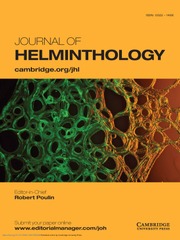Article contents
The influence of temperature and osmotic stress on the development and eclosion of hookworm eggs
Published online by Cambridge University Press: 18 November 2009
Abstract
Time lapse video micro recording techniques have been used to investigate the development and eclosion of Ancylostoma ceylanicum and A. tubaeforme eggs under a range of temperature and osmotic conditions. Over the range 15 to 35°C increasing temperature resulted in decreased development time, the hyperbolic form of the curve being similar to that found by other workers. The adoption of a developmental parameter to mark the start of timing provided more reproducible results than previously reported. Osmotic stress in the range 0·600 mOsM/kg provided by a number of inorganic salts and organic sugars increased hatching time but did not greatly reduce the percentage that hatched. There was no correlation between the ionic composition of the solution and its effect on the eggs. Solutions of EDTA, carbonates and iodides markedly reduced hatching. Behavioural studies of the pre-hatched larvae suggested that the eggs were permeable and susceptible to osmotic and ionic changes early in their development and well before they were ready to hatch. No appreciable differences were found between the two species of hookworm investigated.
- Type
- Research Article
- Information
- Copyright
- Copyright © Cambridge University Press 1985
References
REFERENCES
- 8
- Cited by


